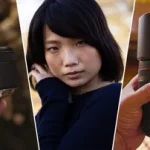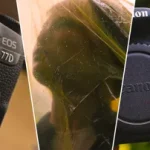Today, we’re going to compare two budget lenses. The Canon EF-S 24mm ‘Pancake Lens’そして キヤノンEF-S 18-55mmキットレンズ. In this review, I’ll tell you what they’re good for, what they’re not good for, and we’ll uncover a major flaw that they both have.

絞りと焦点距離
Right, so first off, let’s discuss focal length. The EF-S 24mm lens, dubbed the ‘pancake lens’, has a focal length of 24mm. The fewer millimetres you have, the wider your frame is, and the more you can fit in it.
A lens with a longer focal length would be more zoomed in. Ok, so why does the EF-S 18-55mm kit lens have two numbers?
That is because the 18-55mm lens has a variable focal length. You can also say that it is a zoom lens. In other words, when you zoom it in and out, its focal length actually changes.
When you’re zoomed all the way out, so the lens is at its widest, and you can fit loads in frame, you’re at 18mm. When you zoom all the way in, so you can photograph something at more of a distance, you’re at 55mm.
So the 24mm has a fixed aperture, while the 18-55mm lens’s aperture is variable. Is there any reason why you might want to have a fixed aperture?
プライム
Yes, there is. A lens with a fixed aperture, also known as a prime lens, tends to produce sharper images. Also, they tend to have wider apertures, and thus allow in more light.
Speaking of apertures, if you look at the name of the Canon EF-S 24mm f2.8, you might wonder what that f stands for.
In short, the number that follows after f is the maximum aperture, or the maximum amount that the lens can open. In this case, it’s f2.8.
The lower the number is, the more the lens can open, and thus more light is allowed in.
You might have noticed that the EF-S 18-55mm kit lens actually has a much stranger number, f3.5-5.6. Let’s break that one down.
Light
You see, when you’re zooming the lens in and out, the aperture can actually change along with the focal length. If you’re zoomed all the way out, at 18mm, and you open your aperture as much as you can, which is f/3.5, when you zoom in, the minimum aperture will actually automatically go up.
In other words, when you’re zoomed all the way out, the maximum you can do is f3.5, whilst when you’re zoomed all the way in, you can only do f5.6.
If you want to think of it in terms of light, the lens allows in the most light when it’s zoomed all the way out, and the least amount of light when zoomed all the way in.
Since we keep bringing up light, let’s discuss what these lenses can do with it, and what kind of image quality they can achieve.
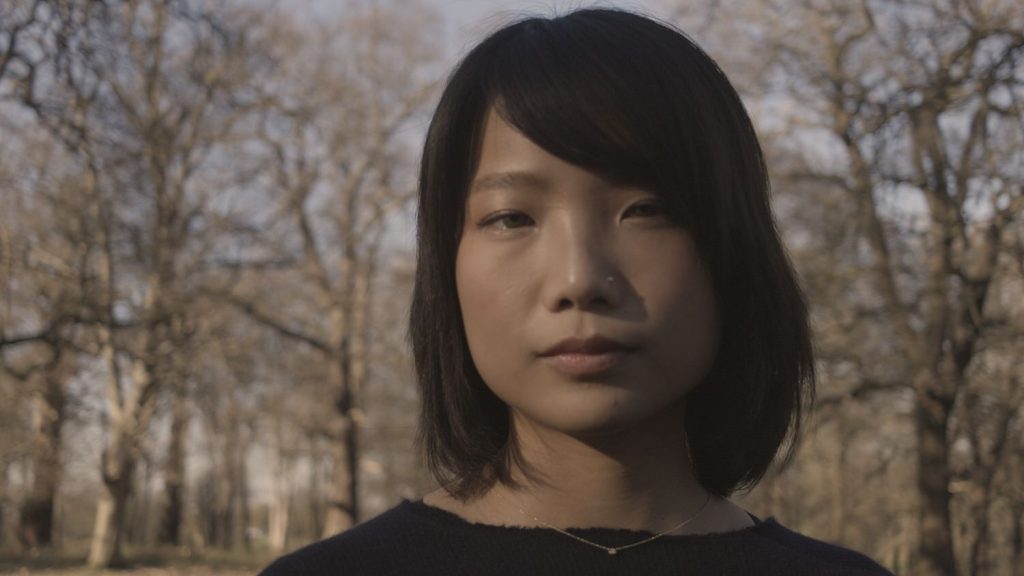
画質
Frist off, let’s bring up the flaw with one of these two lenses; the 18-55mm lens specifically.
Light
When using this lens, especially for portraits, you might find that you prefer to mostly have it zoomed in. This is because a longer lens tends to produce more background blur, which is usually desirable in portraits.
As a result, the widest aperture you’ll be able to use is f5.6. Now, you might have also heard that the best time to take photos, especially portraits, is around golden hour, which is the 1 hour period before the sun goes down.
Now, as you actually get closer and closer to sunset, there will obviously be less and less light available. As it gets darker and darker, you’ll find that your images get noisier and noisier.
You’ll try to lower your shutter speed, to allow for more light, but at some point, you’ll start to get motion blur in the images. At that point, since you can’t push the aperture or shutter speed any further, you’ll have to bump up the ISO.
The higher the ISO, the more noise in your images. This is not ideal.
So, what can you do? If you only have the 18-55mm kit lens, not much, other than introducing some artificial light. The weakness of the 18-55m kit lens is that it really doesn’t do well in low-light conditions.
一方 EF-S 24mm f2.8 does quite a bit better, since it can open up to f/2.8. That means that you not only get more light, but you also get more background blur, or Bokeh. The lower the f-number, the more background blur.
シャープネス
Right, what about sharpness?
As discussed earlier, prime lenses tend to be sharper than variable ones, and so, overall, the 24mm lens is sharper. Generally speaking though, both are sharper in the centre, and less so in the corners.
This is typical of more budget lenses, though I don’t believe it to be much of a problem. In most cases, your subject will be in the centre of the image, and people who look at photos tend to mostly focus on the centre anyway.
口径食
Next up, what about vignetting?
Vignetting is when the corners of your image are a bit darker than the centre. Again, this is quite common with more budget lenses, but once more, it’s not a huge issue, especially for portraits.
The reason why I say this is because when doing portraits, your subject is usually in the middle of the photo. Since you want to draw attention to their face, darkened corners will naturally lead the viewer’s eyes more towards the centre.
色収差
Ok cool. What about chromatic aberration?
When taking photos, especially towards sunset, if you zoom in on straight lines in your photos, you might notice a kind of colour bleed.
I’d say that the 18-55mm probably does it a bit more than the 24mm, but in this case as well, it’s no biggie. If you take photos for other photographers, they might zoom in, and check for it, but regular people will not.
In fact, someone who is not a photographer might even like it, as it adds kind of a cool effect, at least in my opinion.
手ブレ補正
Right, what about IS, or image stabilisation?
について EF-S 18-55mmキットレンズ does have it, but the 24mm does not. In fact, this is one of the flaws of the 24mm lens. You see, budget cameras don’t have in-body image stabilisation, which means that the only place you can really get it at this price level is either from the lens, or from a tripod.
The 18-55 stabilises the image optically somewhat, which means smoother video, and sharper photos. The 24mm lens can’t do that at all, which is especially a problem for video. We’ll discuss that in a bit more detail later in the review.
オートフォーカス
Ok, what about autofocus capability?
Neither of these lenses has super-fast autofocus, and when actively focusing, both can create a slight mechanical buzzing sound. This isn’t a problem for photos, but it can be for video.
Right, and finally, before we move on, what is their minimum focusing distance? You see, with any lens, there is only so close that you can get to a subject, before it fails to focus.
So basically, any lens needs a minimum distance from the subject, in order to focus. In the case of the EF-S 24mm f/2.8 lens, that distance is 16cm, or 6.24″. In the case of the EF-S 18-55mm kit lens, it is 25cm, or 9.84″.
Therefore, the 24mm lens can get quite a lot closer to its subject. Do bear in mind that a lens that wide, that close to its subject, will distort the image noticeably.
This may not be a bad thing, depending on what you’re after, but it’s good to know.
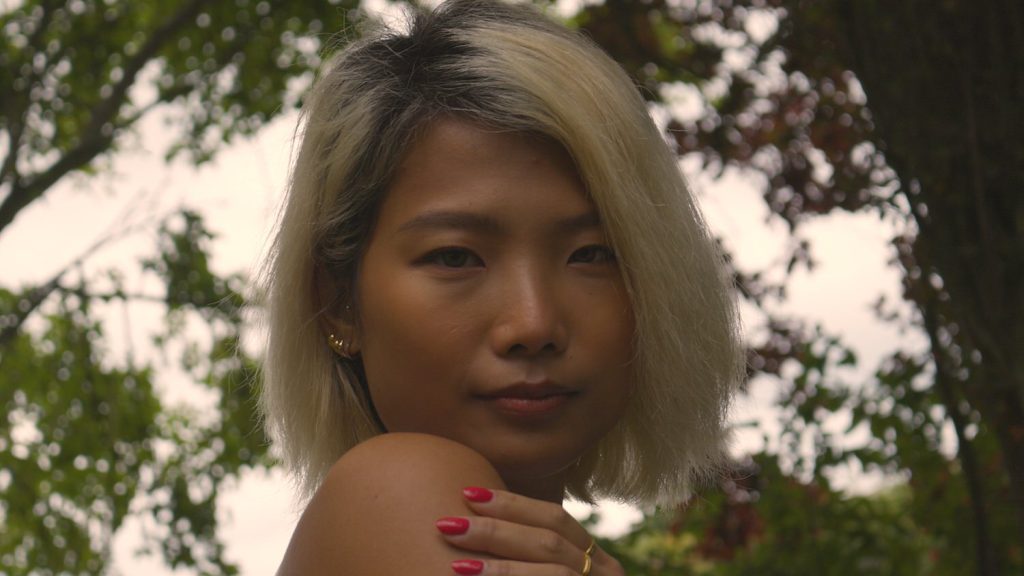
サイズ
So, how portable are these lenses?
について EF-S 24mm measures 68.2 x 22.8 mm, or 2.69 x 0.9″, and weighs in at around 125g, or 4.41oz. On the other hand, the EF-S 18-55mm lens measures 66.5 x 61.8mm, or 2.6 x 2.4″, and weighs 215g, or 7.6oz.
Even though both of these lenses are relatively small and lightweight, the EF-S 24mm is clearly far more portable. In fact, there is a reason why it has been nicknamed the ‘pancake lens’.
Now, since we’re discussing portability, you also have to take the camera into account. Which cameras can I actually use these two lenses with?
互換性
So, both of these lenses have EF-S in the name. What that means is that they are compatible with cameras that have EF-S mounts. Luckily, this makes up the majority of Canon’s budget cameras, like the Rebel series, for example.
If you’re not sure, search for the camera name, and add ‘mount’ to the query. So, if you want to know if the キヤノン77D can use EF-S lenses, look up something like ‘Canon 77D mount’.
If the camera has an EF/EF-S mount, then yes, it can use these lenses. On the other hand, if the camera has an EF mount, that means that it can not use them. The lenses will not physically connect to the camera mount.
By the way, I’ve reviewed quite a few Rebel cameras on my Youtube channel, feel free to have a look.
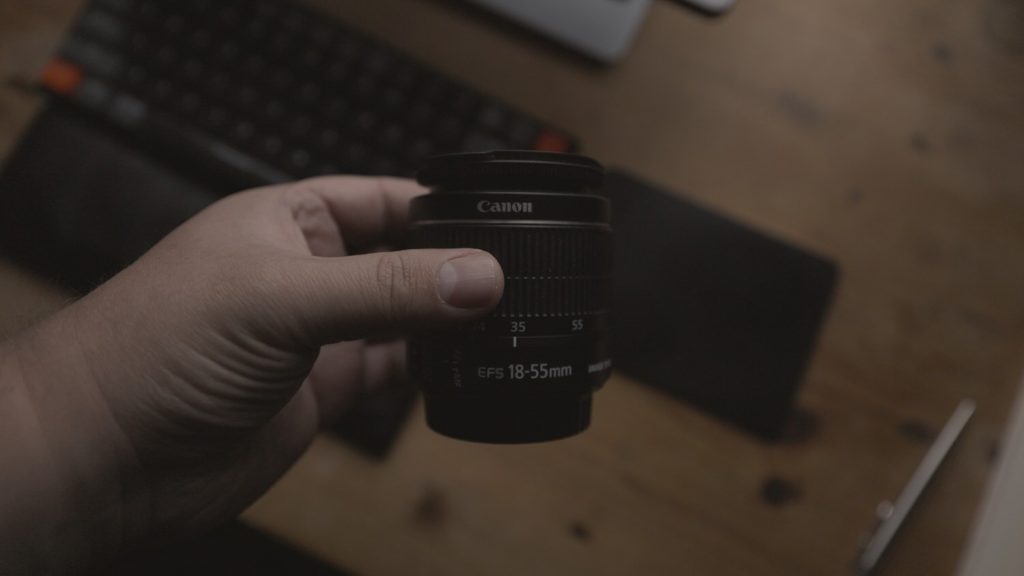
アプリケーション
Now, what are these two lenses actually designed for?
So, the 18-55mmレンズ is a general lens. It’s designed to do loads of things, but it’s not fantastic at anything in particular. It’s a fantastic lens to start off with, as it allows you to do many things, and that will enable you to decide what direction you want to take, and thus which specialised lenses you want.
For example, you can zoom it all the way out, and do some wide landscapes. You can zoom it in a bit, and photograph some architecture, or zoom it all the way in, and do some portraits.
It won’t be great in low-light conditions, but it will do ok for most of the day. It also has IS, which is a great help when doing vidoe.
We’ll talk more about video in a bit, actually.
Wildlife
As a quick side note, technically you can use this lens to capture some wildlife, or sports, but not very well, as 55mm won’t allow you to zoom that much, really.
Ok, so what about the 24mm lens. What is it designed for?
So, it actually works quite well in many scenarios. You can do wide landscapes, capture more of a street scene, fit more of a building into frame, and it even works well for portraits, which surprised me.
When doing portraits with it though, it’s important not to get too close to the subject, as it can distort their face in rather strange ways. If that is exactly what you want to do, then go ahead.
Naturally, because this is a wider lens, it’s not great for wildlife, or sports. It just won’t allow you to zoom in anywhere near enough for that. In fact, it won’t allow you to zoom in at all, but you know what I mean.
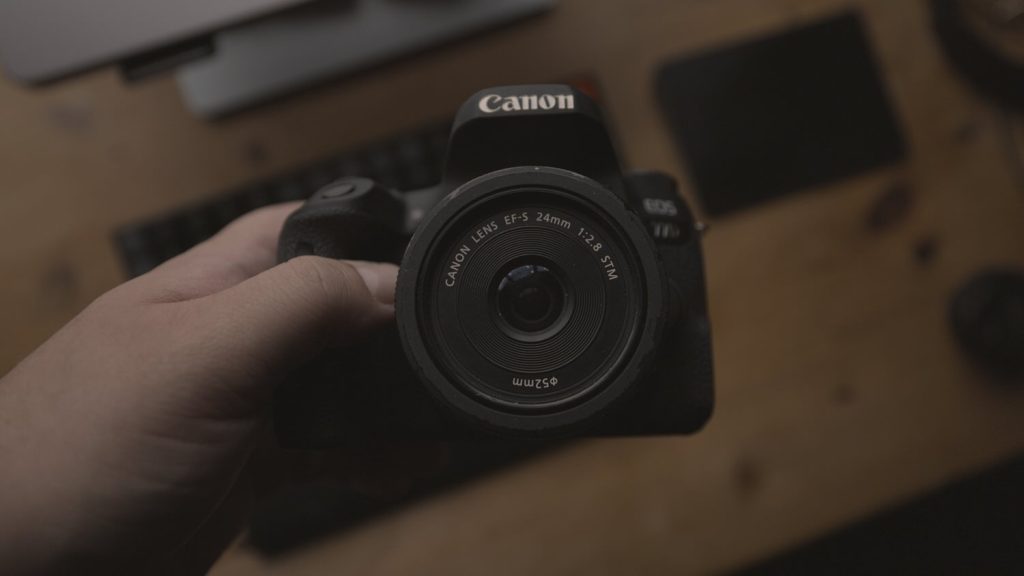
ブログ
Right, so what if I want to vlog? Would either of them work for that? Sure, they both would, but one is a clear winner.
Now, both of them are rather wide, which is good, as it allows you to fit more of yourself in frame, but you do have to make a choice.
So, the 24mm lens allows in a lot more light, which is great when vlogging, as it allows you to actually be able to vlog in more places. Light would be less of a concern.
On the other hand, it does not have IS, which the 18-55mm kit lens does. In the case of handheld vlogging, the lack of IS in the 24mm lens will be quite evident.
Your footage will be a lot shakier. Now, if that’s what you’re going for, then great, but most vloggers prefer to have smoother footage.
So, you have a decision to make. Smoother footage, but with more noise when not a lot of light is available, or brighter footage, but with more shake.
That’s not necessarily a choice you have to make when looking at far more expensive lenses, but when on a budget, a decision does have to be made.
ユーチューバー
But what if I want to sit down, and film YouTube videos. Does the lack of IS matter that much?
If your camera is on a tripod, then no, the IS does not matter. Technically the 24mm lens should win here, but I don’t know, I like the fact that the 18-55mm gives me more options in terms of look.
Filming yourself at 18mm will create a different image when compared to 55mm. This mostly has to do with the fact that the focal length of a lens will distort your face somewhat.
I think I’d rather take the 18-55mm kit lens in this scenario, as it gives me more options in that sense.
コントロール
Right. So if I want to actually change the focal length, how easy is it to do? How easy are these lenses to use?
In the case of the 24mm lens, you can’t actually change the focal length, so you only get a manual focusing ring. With the 18-55mmキットレンズ, you get your focusing ring, but you also get your zoom ring.
Turning it is what enables you to change the focal length.
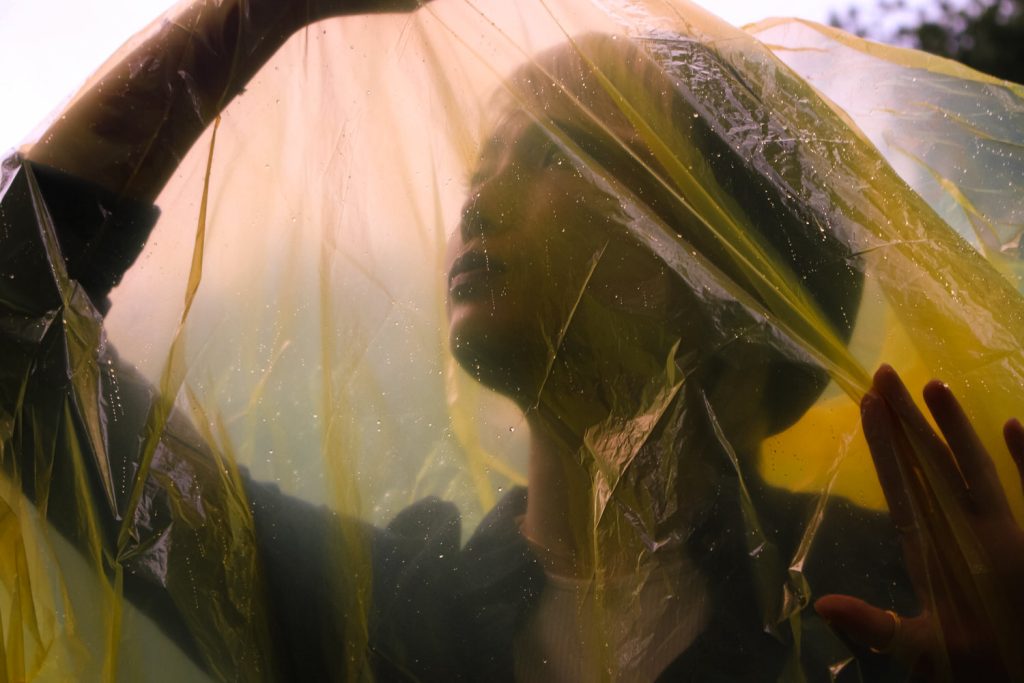
長寿
Ok, so I’m probably going to want to use either of these lenses for a while. How long can I expect them to actually last?
This really depends on how you treat them. Both of them are rather plasticky, and have no weather sealing. I wouldn’t use them in the rain, for example.
I also like to use UV filters on my lenses. They theoretically degrade the image quality a tiny little bit, but it’s such a small amount that you’ll never notice.
The image degradation occurs as a result of light having to also pass through the glass of the filter, in order to get to the sensor.
I’d rather just take a small hit in terms of quality, rather than risk breaking the glass element. It’s up to you what you want to do.
結論
So in conclusion, which one should you get?
I’d go for the 18-55mm lens if you’re just getting started. The reason is that it’s a lot more versatile, and thus it will teach you a lot more.
The fact that it has built-in image stabilisation is also a bonus, especially if you also want to do video.
If, on the other hand, you mostly want to focus on photos, and you’re looking for a decent second lens, the 24mm would be a good choice. This is especially the case if you want to take photos in low light conditions, as outlined earlier in the review.
Both of them are good at a lot of stuff, but they each of course have their strengths and weaknesses. By the way, if you want to see how much they cost where you are, I’ve added affiliate links down below, including for eBay, and other similar shops, in case you want to buy them second hand.
推薦の言葉
の比較レビューをお読みいただきありがとうございます。 Canon EF-S 24mm 対 EF-S 18-55mm Kit Lens.私の他の記事もぜひご覧ください。あなたが以下のことに興味があろうとなかろうと、私たちは皆のために何かを用意している。 オーディオあるいは カメラとレンズ.ビデオレビューがお好きな方は、私のビデオをご覧ください。 YouTubeチャンネル.
最後に、この記事で紹介したすべてのアイテムを以下に掲載する。
